Gwynedd
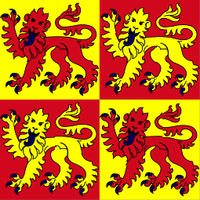
Gwynedd was a petty kingdom of northern Wales created in the early Dark Ages and surviving until conquered by King Edward I of England in 1283. Gwynedd has pride of place amongst the Dark Age Welsh principalities, as it was usually the most powerful of them. The early kings of Gwynedd were recognised amongst the Welsh as bearing the title "King of Britain", and in its last days the rulers of Gwynedd attained the title "Prince of Wales".
Late Roman documents describe the land around today's Caernarfonshire as Venedotia, which is a Latin form of the native Gwynedd. The bounds or Gwynedd grew and shrank across the ages and the kingdom was repeatedly divided, but its typical area was from the River Dovey in the south to Anglesey in the north and from the Irish Sea to a boundary shifting back and forth in the east. The rival kingdom of Powys bordered Gwynedd in the south-east. Gwynedd's strength lay in part due to the region's mountainous geography: Snowdonia lay at its heart, which made it difficult for foreign invaders to campaign in the country and impose their will effectively.
Popular tradition attributed to Nennius, a 10th-century Welsh chronicler, traced Gwynedd's foundation to Cunedda. According to Nennius, Cunedda migrated with his sons and followers from Lothian (the lands south of the Firth of Forth) in the 5th century. The main court of the Kingdom of Gwynedd was originally at Deganwy Castle, where Maelgwn Gwynedd (died 547) had his stronghold. For a time it was moved to Aberffraw on Anglesey, and in the thirteenth century, Llywelyn Fawr and his successors had Abergwyngregyn on the north coast of Caernarfonshire as their capital.
Name
The earliest form of the name is found in Latin as Venedotia, which is derived from the Welsh name now written Gwynedd. John Koch and several other historians[1] reckon this to be is derived from the Irish word "Feni", referring at one time to a specific group on the island and later broadening to become a general reference to the Irish people as a whole. The Irish, especially the Laighin, are known to have colonized and/or conquered much of northern Wales in the mid-4th to early 5th centuries.
Alternatively, the name Gwynedd may derive from Brythonic Ueneda, which may be akin to Old Gaelic Fenia (whence fiana; "war-band"). Thus the possible meaning may be "Warrior Bands".
The name is also similar to that of the kingdom's legendary founder, Cunedda.
Whatever the true origin of the name, a gravestone from the late 5th century now in Penmachno church seems to be the earliest record of the name. The Latin inscription is: "Cantiorix hic iacit/Venedotis cives fuit/consobrinos Magli magistrati", ("Cantiorix lies here. He was a citizen of Gwynedd and a cousin of Maglos the magistrate").
History
The history of the Kingdom of Gwynedd is told in the deeds of kings and princes, and it is usually a bloody tale. On occasion a great ruler appeared to reform and develop his lands, but as often as not at this death the kingdom was divided and cast into strife.
The Sons of Cunedda
The foundation of the kingdom came out of the collapse of Roman power; western Britannia reverted quickly to tribal law and petty states, and raiders from Ireland fell upon the coasts, first as raiders, later as colonists. Legend, supported by some later written accounts, asserts that a prince called Cunedda (modern "Kenneth") from distant Manaw Gododdin came to free these lands from the Irish scourge in about 450 AD. He and his eight sons expelled the Irish and upon his death the realm was divided between his sons following ancient British tradition. From these beginnings many of the ancient divisions of Gwynedd occur; his son Dynod was awarded Dunoding, another son Ceredig achieved Ceredigion and so forth. Cunedda's heir, Einion Yrth cast the last Irish out of Anglesey in 470. Einion Yrth's son Cadwallon Lawhir appears to have consolidated the realm during a time of relative peace. After Cadwallon, Gwynedd appears to have held a pre-eminent position amongst the petty Cambrian states in the post-Roman period. So much though is in legend.
- Maelgwn: The first king to step out of legend and into history is Maelgwn Hir (Maelgwn the Tall), great-grandson of Cunedda. Several wild legends attach to Maelgwn, and he is attributed in some old stories as hosting the first Eisteddfod. Gildas, writing in about the 540s, castigated five British kings then ruling and one was Maelgwn. In his De Excidio et Conquestu Britanniae ("On the Ruin and Conquest of Britain") Gildas condemns Maelgwn (by the name Maglocunus, meaning "Prince-Hound") describing him as "the dragon of the island" and as the most powerful of the five named British kings:
"...you the last I write of but the first and greatest in evil, more than many in ability but also in malice, more generous in giving but also more liberal in sin, strong in war but stronger to destroy your soul...."
Gildas: De Excidio et Conquestu Britanniae
Maelgwn died of the plague in 547, leaving a succession crisis, a frequent occurrence in Gwynedd's history.
- Rhun: Rhun Hir. Maelgwn's son, fought his own brother in law, Elidyr Mwynfawr of Strathclyde, and armies marched from Arfon to the Clyde in attack and revenge. Rhun was ultimately successful. And succeeded by his son Beli in c.586.
- Iago (Iago ap Beli) (from c.599) allied with Powys against advancing English but were defeated at the Battle of Chester in 613, bring the English to west coast of Britain and the dividing the lands henceforth to be known as Wales from "the Ancient North".
Cadwallon
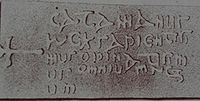
Cadwallon ap Cadfan (c.624 - 634), was the grandson of Iago ap Beli, and his famous and infamous, belligerent reign was marked with extremities in the fortunes of the Britons. Cadwallon held two titles inherited from his ancestors at least since Maelgwn: King of Gwynedd and King of Britain, for he was recognised as the High King of the native Britons, and intended to make this title a reality and break the power of the English peoples that had been advancing across Britain for a hundred years.
On attaining the throne, Cadwallon attacked the Northumbrians, whose kingdom had been expanding rapidly, but was defeated: King Edwin overran all Gwynedd and Cadwallon fled to Ireland. In time, Cadwallon returned, allied with the pagan English king Penda of Mercia and struck against King Edwin in Northumbria; the allies defeated Edwin at Hatfield Chase and Cadwallon, King of Britain, became the effective ruler of all north Britain, but instead of ruling, his armies devastated Northumbria, captured and sacked York in 633 and terrorised the population; contemporary accounts say that Cadwallon massacred so many of the English that they believed it was his intention to exterminate them. They were probably right.
"...he neither spared the female sex, nor the innocent age of children, but with savage cruelty put them to tormenting deaths, ravaging all their country for a long time, and resolving to cut off all the race of the English within the borders of Britain."
Bede (Historia ecclesiastica gentis Anglorum)
However, Cadwallon's time of bloody glory was short-lived, for Oswald, of the Northumbrian royal house, raised an army and defeated and slew Cadwallon in battle in 634 at Heavenfield close to Hadrian's Wall. The Welsh would never more threaten a reconquest of lowland Britain and Gwynedd contracted to its heartland.
Cadwallon was succeeded by his son Cadwaladr, who was the last king known as King of Britain. Cadwaladr presided over a period of consolidation and devoted much time to the Church earning the title Fendigaid meaning "blessed".
Rhodri the Great and successors
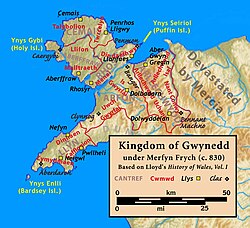
In 825 the House of Cunedda expired in the male line in 825 on the death of Hywel ap Rhodri Molwynog and, as Sir John Edward Lloyd put it, "a stranger possessed the throne of Gwynedd",[2] albeit a stranger who claimed descent from Cunedda: Merfyn "Frych" ("the Freckled"), who founded the House of Aberffraw, named after his principal court at Aberffraw on the Isle of Anglesey.
- Rhodri Mawr ("the Great") (844 - 878), son of Merfyn Frych became the first ruler since the days of Cunedda to control the greater part of Wales. His kingdom however was divided on his death.
- Anarawd ap Rhodri: the first King of Gwynedd to acknowledge allegiance to the King of the English.
- Idwal Foel' rebelled against King Edmund and was slain in battle: in 942 King Edmund placed Hywel Dda, King of Deheubarth (a junior descendant of Rhodri Mawr) on the throne. On Hywel's death in 950 the House of Aberffraw was restored, but anarchy prevailed.
- Gruffudd ap Llywelyn, King of Powys took the throne in 1039 and by 1055 was king over most of Wales: the first and only Welsh prince to achieve such power. England was weakly ruled, so he annexed some English towns and burnt Hereford; Harold Godwinson turned on him, ravaged Wales and saw to it that Gruffudd was put to death by his own men.
The Norman conquered England in 1066 and turned their attention to the Welsh states. The endless internal strife of Gwynedd allowed Norman adventurers to make gains, until Gruffydd ap Cynan, the exiled grandson of Iago ab Idwal, seized the throne.
Gruffydd ap Cynan
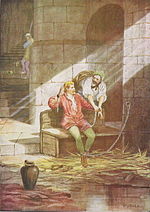
T. Prytherch, 1900
Gruffydd ap Cynan repeatedly attempted to seize the throne form 1075, and was repelled by the Normans, until a successful return from exile in 1098 and a battles with Norman adventurers. King Henry I granted him the kingship over Gwynedd's lands in 1101: Henry I recognized Gruffydd's ancestral claims to the lands of upper Gwynedd to the Conwy in a settlement which divided Wales between the lands under Welsh princes and the Welsh Marches, under the control of Anglo-Norman lords.[3] Author and historian John Davies notes that the border shifted on occasion, "in one direction and in the other", but remained more or less stable for almost the next two hundred years.[3] Nevertheless, Gruffydd could expand his borders at the expense of neighbouring princes thereafter.
After generations of incessant warfare, Gruffydd began the reconstruction of Gwynedd, intent on bringing stability to his country.[4] According to Davies, Gruffydd sought to give his people the peace to "plant their crops in the full confidence that they would be able to harvest them".[4] Gruffydd consolidated princely authority in north Wales, and offered sanctuary to displaced Welsh from the Perfeddwlad, particularly from Rhos, at the time harassed by Richard, 2nd Earl of Chester.
Sheltering alleged rebels brought King Henry's wrath upon his tributary king; King Henry, assisted by King Alexander I of Scotland, invaded Gwynedd and Powys in 1116. No battles nor skirmishes were fought, but Gruffydd made a truce, rendered homage and fealty and paid a heavy fine.
Gruffydd's policy in his remaining years, and which his sons would execute and later rulers of Gwynedd adopted, was to recover Gwynedd's primacy without blatantly antagonizing the English crown.[4]
The stability of Gruffydd's long reign allowed his subjects to plan for the future without fear that home and harvest would "go to the flames" from invaders.
Settlements became more permanent, with buildings of stone replacing timber structures. Stone churches in particular were built across Gwynedd, with so many limewashed that "Gwynedd was bespangled with them as is the firmament with stars". Gruffydd had built stone churches at his princely manors, and Lloyd suggests Gruffydd's example led to the rebuilding of churches with stone in Penmon, Aberdaron, and Towyn in the Norman fashion.
Owain Gwynedd
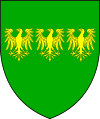
Owain I ap Gruffydd was possibly the most famous of the rulers of Gwynedd, and he was the last ruler to bear the title "King": his successors would be "Prince of Gwynedd". Owain's rule coincided with that of the most powerful mediæval King of England: King Henry II.
Owain succeeded his father to the greater portion of Gwynedd, while Cadwaladr, Gruffydd's youngest son, received the commote of Aberffraw on Anglesey, and the recently conquered Meirionydd and northern Ceredigion, that is Ceredigion between the rivers Aeron and Dovey.[5] Owain and Cadwaladr came to blows in 1143 when Cadwaladr was implicated in the murder of Prince Anarawd ap Gruffydd of Deheubarth, Owain's ally and future son-in-law, on the eve of Anarawd's wedding to Owain's daughter. The breach between the brothers was exploited by Owain's rivals, the marcher lords and in due course King Henry II.
Owain's largely successful struggles against Madog ap Maredudd of Powys and against the Earl of Chester cannot briefly be told, but King Henry II was roused against the overmighty Owain of Gwynedd. By 1157, Owain's enemies had joined Henry II's camp, including Cadwaladr and Madog of Powys.[6] Henry II marched from Chester but Owain caught his flanking forces by surprise and in the melée King Henry barely escaped with his life. Owain repositioned himself first at St Asaph, then further west, clearing the road for Henry II to enter into Rhuddlan "ingloriously".[6] Once in Rhuddlan Henry II received word that his naval expedition had failed, as instead of meeting Henry II at Degannwy or Rhuddlan, it had gone to plunder Anglesey.
In a later letter to the Byzantine Emperor, Henry probably recalled these experiences when he wrote of the Welsh:
A people called Welsh, so bold and ferocious that, when unarmed, they do not fear to encounter an armed force, being ready to shed their blood in defence of their country, and to sacrifice their lives for renown.Encyclopaedia Britannica: Wales
Owain Gwynedd was no fool and recognized the need to agree terms; he rendered homage and fealty to the King, and resign Tegeingle and Rhuddlan to the Earl of Chester, and restored Cadwaladr to his possessions.[6]
Owain henceforth determined to expand Gwynedd without rousing the English crown: a policy of outward conciliation, while masking his own consolidation of authority, in particular at the expense of Powys.
Henry's troubles with Thomas Becket, the Archbishop of Canterbury, causing divisions at court and an opportunity: Owain Gwynedd joined with Rhys ap Gruffydd of Deheubarth in a grand revolt against the King. Henry was typically robust in his response, raising a vast army drawn from all over the Angevin empire, assembling in Shrewsbury, and he paid the Norse of Dublin to harass the coast of the rebels' lands. Owain's son Dafydd struck first, raiding Angevin positions in Tegeingle and exposing the castles of Rhuddlan and Basingwerk to serious dangers; King Henry himself rushed to north Wales for a few days to shore up defences there, before returning to his main army now gathering in Oswestry.
Owain's achievement cannot be underestimated: having once roused the hatred of the other princes for his aggression, Owain was now the war chief of several principalities, with Cadwaladr as his second. Nevertheless, it was faced with the largest army of invasion yet assembled for their conquest. Owain assembled his army at Corwen in the vale of Edeyrion, a strategic position.
King Henry's army advanced from Oswestry, crossing the mountains towards Mur Castell, and found itself in the thick forest of the Ceiriog Valley where they were forced into a narrow thin line, harassed by Owain's skirmishers rushing from the woods. In a dry summer the moors may have been passable, however the mountain weather struck, the rain fell in torrents flooding the meadows until the great encampment became a morass, and the wind did not let up, diminishing provisions along an exposed supply line stretching through hostile country; Henry II was forced into a complete retreat without even a semblance of a victory.
King Henry II's Welsh campaign was a complete failure, with the king abandoning all plans for the conquest of Wales. Owain had gained effective independence from his overlord and even sought an alliance with Louis VII of France in 1168, which came to nothing.
Like his father before him, Owain I promoted stability in upper Gwynedd as no army was able to strike past the Conwy, marking nearly 70 years of peace in upper Gwynedd and on Anglesey. Henry II ruled England and most of France and much of Wales outside Owain's domain, and the King of Scots served in his army. Henry conquered Ireland, but Owain Gwynedd defeated him.
After Owain's death, Gwynedd was divided and civil war raged across the realm.
Llywelyn the Great to Llywelyn the Last
- Llywelyn ap Iorweth, later known as Llywelyn the Great, was sole ruler of Gwynedd by 1200, and made a treaty with King John of England the same year. Llywelyn's relations with John remained good for the next ten years. He married John's illegitimate daughter Joan, also known as Joanna. Relations later broke down such that in 1211 John invaded Gwynedd. At the revolt of the barons, Llywelyn joined the barons in driving the King to sign Magna Carta in 1215. By 1216 he was the dominant power in Wales, holding a council at Aberdyfi that year to apportion lands to the other princes.
- Dafydd ap Llywelyn: King Henry III accepted Dafydd as prince but without his father's conquests outside Gwynedd. His half-brother Gruffydd was held as a hostage, but in March 1244 Gruffydd tried to escape from the Tower of London by climbing down a knotted sheet, and fell to his death.
- Llywelyn ap Gruffydd: Llywelyn succeeded while his elder brother Owain was imprisoned. Owain escaped or was released from Chester immediately after the news of Dafydd's death reached England and Llywelyn and Owain divided the realm between them. Llywelyn after his death was to earn the name "Llywelyn the Last".
Between 1255 and 1258 Llywelyn orchestrated a campaign against England across all of Wales gaining allies in Deheubarth and Powys. By 1258 he was acknowledged by almost all the native rulers as Prince of Wales. In 1264, the Baron's Revolt in England had reached its climax at the Battle of Lewes. Llywelyn signed a treaty with the rebel leader Simon de Montfort and married his daughter, Eleanor. De Montfort was soon defeated and killed but peace remained and Llywelyn's title "Prince of Wales" was recognised by the King. All the native Welsh princes were to be vassals of Llywelyn and it is from this point that the independent history of the kingdom of Gwynedd comes to an end.
However after the death of King Henry III in 1272, the peace was short-lived. King Edward I declared Llywelyn a rebel and an enormous invasion force broke upon north Wales: Llywelyn was forced back into Snowdonia. He sued for peace and was forced to sign the Treaty of Aberconwy reducing his realm to almost same extent that had existed at the beginning of his reign in 1247; confined to the lands above the Conwy. Llywelyn's princess, Eleanor de Montfort, died during childbirth in 1282, giving birth to Llywelyn's only child, a daughter, Gwenllian. This seems to have driven Llywelyn into what some historians have speculated to be a nervous breakdown and incapacitated him.
In 1282 Llywelyn began his last rebellion, and on 11 December 1282, he was killed at Cilmeri in disputed circumstances. His leaderless forces were routed shortly afterwards and Edward had snuffed out at last ancient Gwynedd.
Llywelyn's brother Dafydd proclaimed himself Prince of Wales and fought but in vain; on the 22 June 1283 he was captured in the uplands above Abergwyngregyn close to Bera Mawr. It is likely that his wife, daughters, niece and one of his sons were captured alongside him: Gwenllian, Llywelyn's daughter was sent to the monastery at Sempringham and others of the princely house were places in close confinement. Following this, any organised resistance ended until the uprising of Madog ap Llywelyn some eleven years later. The lands that had been Gwynedd were at peace for the first time perhaps since the foundation of that realm eight centuries before.
Principality of Wales
The lands of the kingdom were annexed to England and the Statute of Rhuddlan of 1284 broke the Kingdom of Gwynedd up and re-organised it into counties on the English model: Anglesey, Caernarfonshire, Flintshire and Merionethshire, and in the south Carmarthenshire and Cardiganshire which became a new Principality of Wales under the English crown. The Prince of Wales now however was retained by the sovereign eventually to be awarded to his son, Prince Edward (later Edward II).
Heirs to the House of Aberffraw
The royal house of Gwynedd may have endured in the guise of the Wynn and the Anwyl families who both claimed Rhodri ab Owain Gwynedd as their ancestor. After the purges in Wales had finished in the 16th century a certain John Wynn (Ioan ap Morys) of Gwydir proved his royal ancestry and he and his descendants were recognised across north Wales as the inheritors to the Princes of Gwynedd until the male line of the Wynn family died out, probably in the late 18th century.
Another claim could come by way of the surviving members of the Anwyl of Tywyn Family or from any surviving male descendants of Dafydd Goch, the acknowledged bastard son of Dafydd ap Gruffudd who avoided detection during the royal purges and continued the line.
Rulers of Gwynedd
House of Cunedda
- Cunedda Wledig ap Edern (Cunedda the Emperor) (c.450–c.460)
- Einion Yrth ap Cunedda (Einion the Impetuous) (c.470–c.480)
- Cadwallon Lawhir ap Einion (Cadwallon Long Hand) (c.500–c.534)
- Maelgwn Hir ap Cadwallon (c.520–c.547)
'*Rhun Hir ap Maelgwn (Rhun the Tall) (c.547–c.580)
- Beli ap Rhun (c.580–c.599)
- Iago ap Beli (c.599–c.616)
- Cadfan ap Iago (c.613–c.625)
- Cadwallon ap Cadfan (c.625–634)
- Cadafael Cadomedd ap Cynfeddw (Cadfael the Battle-Shirker) (634–c.655)
- Cadwaladr Fendigaid ap Cadwallon (Cadwallader the Blessed) (c.655–c.682)
- Idwal Iwrch ap Cadwaladr (Idwal Roebuck) (c.682–c.720)
- Rhodri Molwynog ap Idwal (Rhodri the Bald and Grey) (c.720–c.754)
- Caradog ap Meirion (c.754–c.798)
- Cynan Dindaethwy ap Rhodri (c.798–816)
- Hywel ap Rhodri Molwynog (814–825)
House of Manaw
- Merfyn Frych ap Gwriad (Merfyn the Freckled) (825–844)
- Rhodri Mawr ap Merfyn (844–878)
House of Aberffraw
- Anarawd ap Rhodri (878–916)
- Idwal Foel ab Anarawd (Idwal the Bald) (916–942)
- Hywel Dda ap Cadell (Howell the Good) (942–950) (Dinefwr dynasty, descended from the second son of Rhodri Mawr who ruled in Deheubarth, usurps Gwynedd from the Aberffraw line.)
- Iago ab Idwal (950–979) (returns to the Aberffraw branch)
- Ieuaf ab Idwal (950–969)
- Hywel ab Ieuaf (974–985)
- Cadwallon ab Ieuaf (985–986)
10th- and 11th-century usurpations
- Maredudd ab Owain (986–999) Dinefwr dynasty seizes Gwynedd
- Cynan ap Hywel (999–1005) Returns to the Aberffraw dynasty briefly
- Aeddan ap Blegywryd (1005–1018) (minor commote lord usurps Gwynedd from the Aberffraw dynasty)
- Llywelyn ap Seisyll (1018–1023) (Rhuddlan dynasty in lower Gwynedd usurps from Aeddan ap Blegywryd)
- Iago ab Idwal ap Meurig (1023–1039) (Aberffraw dynasty returns)
- Gruffydd ap Llywelyn (1039–1063) (Llywelyn's son Gruffydd usurps from Aberffraw dynasty)
- Bleddyn ap Cynfyn (1063–1075) (Mathrafal dynasty of Powys "receives" Gwynedd from the English King)
- Trahaearn ap Caradog (1075–1081)
Aberffraw restoration
- Gruffydd ap Cynan (1081–1137) (Aberffraw dynasty returns)
- Owain Gwynedd (1137–1170)
- Hywel ab Owain Gwynedd
- Dafydd ab Owain Gwynedd (Dafydd the Usurper) (1170–1195)
- Rhodri ab Owain Gwynedd (1170–1190) (upper Gwynedd until 1174)
- Maelgwn ab Owain Gwynedd (1170–1173), (Anglesey)
- Llywelyn Fawr ap Iorwerth (Llywelyn the Great) (1195–1240)
- Dafydd I (1240–1246) (First acknowledged Prince of Wales)
- Owain Goch ap Gruffydd (Owen the Red) (1246–1255)
- Llywelyn ap Gruffydd (Llywelyn the Last) (1246–1282)
References
- ↑ Christopher A. Snyder (2003). The Britons. Blackwell Publishing.
- ↑ Lloyd (2004), p. 323.
- ↑ 3.0 3.1 Davies (1994), Pura Wallia, Purae Wallie (the Welshries), Marchia Wallie pg 109, 127-130, 137, 141, 149, 166, 176.
- ↑ 4.0 4.1 4.2 Davies: Gryffudd ap Cynan
- ↑ Lloyd (2004), pp. 85, 93, 104.
- ↑ 6.0 6.1 6.2 Lloyd (2004), Owain and Henry II, pp. 99, 1070.
- BBC Wales/History, The emergence of the principality of Wales extracted 26 March 2008
- Barlow, Frank (2000). William Rufus. Yale University Press. ISBN 0-30-008291-6.
- Bartlett, Robert (2000). England Under the Norman and Angevin Kings: 1075-1225. Oxford: Clarendon Press. ISBN 0-19-822741-8.
- Davies, John (1994). A History of Wales. New York: Penguin. ISBN 0-14-014581-8.
- Davies, John (2002). The Celts. New York: Cassell Illustrated. ISBN 1-841-88188-0.
- Evans, Gwynfor (2004). Cymru O Hud. Abergwyngregyn: Y Lolfa. ISBN 0862435455.
- Koch, John. Celtic Culture: a historical encyclopedia. Santa Barbara: ABC-CLIO. ISBN 2005.
- Morris, John E. (1996). The Welsh Wars of Edward I. Conshohocken, PA.: Combined Books. ISBN 0-938289-67-5.
- Lloyd, J. E. (2004). A History of Wales; From the Norman Invasion to the Edwardian Conquest. New York: Barnes & Noble Publishing, Inc.. ISBN 0-7607-5241-9.
- Smith, Beverley J. (2001). Llywelyn ap Gruffudd, Prince of Wales. University of Wales Press. ISBN 9780708314746.
- Stephenson, David (1984). The governance of Gwynedd. University of Wales Press. ISBN 0-7083-0850-3.
- Warner, Philip (1997). Famous Welsh Battles. New York: Barnes & Noble Publishing, Inc.. ISBN 0-7-607-0466-x.